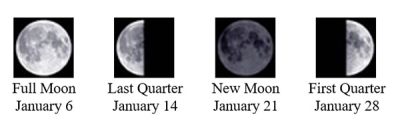The Skies Will Provide a Magical Night of Star Gazing on New Year’s Eve
Opinion Advocates for ideas and draws conclusions based on the author/producer’s interpretation of facts and data.
 By Scott Levine
By Scott Levine
With all the celebrations and merriment as we wind down these last few days of the year, I thought it’d be fun to take a break from all the rushing around. Instead, let’s see what magic is in the night sky as we celebrate on New Year’s Eve.
We’re past the solstice now, which means it’s officially winter. It might be difficult to recognize, but the days are getting longer. It’ll be a few weeks before we really start to notice that extra daylight sneaking in, but it won’t be long.
As the late afternoon darkness falls, the first couple of things we’ll see poking into the fading glow are our solar system’s planets. Reddish Mars, toward the east, and yellowish Jupiter toward the south. The pair have been unmistakably bright for the last few months and are still quite a sight. If you need help, the first-quarter moon will be between them. Just jump to the moon’s left for Mars and to the right for Jupiter.

Toward Jupiter’s right is the subdued-yellow Saturn. It’s fun to imagine where the three planets are and imagine our gaze going deeper and deeper into space. They’re all along the same line, called the ecliptic. Let’s follow the line into the west’s glowing dusk. Maybe we can spot Mercury and Venus, too. They’ll be challenging, low to the horizon and in the sun’s glow, so be patient. That’s all the bright planets in the sky at once.
By around 8:30 p.m., the constellation Orion joins the night in the east. Let’s look for the three stars that make up his famous belt. Once we have them in sight, we can widen our gaze and see the rest of the hunter’s stars fill in around it. The well-known orange supergiant Betelgeuse is to the right of the belt as Orion rises. We can also see the ribbon of bright lights that surrounds Orion, called the Winter Hexagon.
Orion’s belt happens to be a handy tool for finding our way around the night. If we follow the belt upward (toward the west), we’ll come to the V-shaped Hyades, and then the tiny dipper-shaped Pleiades. These are two of the closest star clusters to us.
Downward toward the horizon, we’ll come to Sirius, the brightest star in the night sky. Sirius is always one of my favorites to watch cross the sky. In Westchester, it’s always fairly low to the horizon, so the light we see from it can get mixed up with some disturbances in our atmosphere. These disturbances make it twinkle more than some other stars, and sometimes it even appears to change color before our eyes.
Let’s check in on Sirius and watch it move southward as the evening goes by. Just as the clock strikes midnight and the confetti falls, check in again. Every new year starts with Sirius in that spot, due south, and at its highest point for the night, with Orion standing tall beside it.
It’s always amazing what we can see if we take a few minutes to track them down, and New Year’s Eve is no different. Thanks for reading this year and happy 2023, everyone!
Scott Levine (astroscott@yahoo.com) is an astronomy writer and speaker from Croton-on-Hudson. He is also a member of Westchester Amateur Astronomers, a group dedicated to astronomy outreach in our area. For information about the club including membership, newsletters, upcoming meetings and lectures at Pace University and star parties at Ward Pound Ridge Reservation, visit www.westchesterastronomers.org.

Examiner Media – Keeping you informed with professionally-reported local news, features, and sports coverage.
